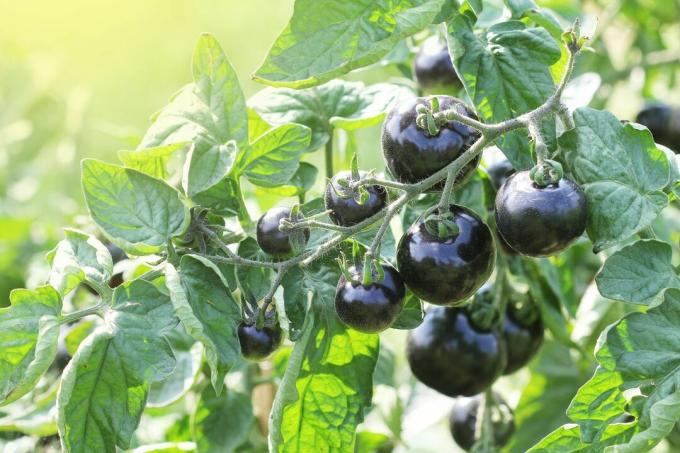The black tomato indigo rose is definitely an unusual sight. We explain everything you should know about the tomato variety - from cultivation to harvest.

There have been more and more in recent years blue and black tomato varieties bred. We are introducing you to one of the very first varieties that brought new color to the tomato world.
contents
- Indigo rose tomato: fact sheet
- Origin and history
- Tomato variety ‘Indigo Rose’: taste and properties
- Growing and caring for the indigo rose
- Indigo Rose: Harvest Time and Uses
Indigo rose tomato: fact sheet
| fruit | Salad tomato / cherry tomato; sunny side: purple to black, shadow side: pink to red |
| taste | mild, not very sweet, rather sour |
| Ripening time | late |
| growth | Stick tomato, up to 180 cm |
| Location | Greenhouse, pot (rain cover) |
Origin and history
The Indigo Rose comes from a breeding program led by Professor Jim Myers at Oregon State University in the USA. In 2012 it was launched as one of the first "Antho tomatoes". Antho is the abbreviation for anthocyanins, the colorants that turn the fruit purple to black when exposed to sunlight.
Tomato variety ‘Indigo Rose’: taste and properties
Even as young plants you can see the dark coloring of the indigo rose, because its leaves and the stem are dark and purple in color. The tomato plant reaches a height of up to 180 centimeters. The round fruits of the Indigo Rose reach the size of a small salad tomato or a large cherry tomato. They hang in panicles of up to twelve tomatoes, each weighing around 40 grams. Depending on the sunlight, the color is darker and can cover the entire fruit. On the shady side, however, you can usually see the actual color of the indigo rose: a delicate pink to red. It does not ripen until late in summer, and the first fruits can be harvested from mid-August. The taste of the indigo rose is very mild, slightly crumbly and somewhat sour, but hardly sweet. It is a seed-resistant variety and can easily be propagated again with the seeds from the fruits.

Growing and caring for the indigo rose
The Indigo Rose is best suited for growing in a greenhouse or in a pot on a warm house wall with a rain cover. The sunnier it is, the darker its color. It can be put in a pot from mid-May after the ice saints. Fill the planter with potting soil that has been specially formulated for tomatoes. Our Plantura organic tomato & vegetable soil is particularly suitable for potted tomatoes, because the nutrients they contain give young plants an ideal start to summer and the flowering period. The black variety also needs a stick in the pot. The Indigo Rose can easily be grown with two or three shoots, the remaining side shoots should be broken off. In the article "Skinned tomatoes”You will find out in detail which side shoots you should remove and how.
From June the indigo rose needs more nutrients in the pot than at the beginning of the planting. To feed its many fruits, the Indigo Rose should be fed with an organic liquid fertilizer such as ours Plantura organic tomato & vegetable fertilizer, get supported. The plant-based fertilizer is added to the irrigation water once a week and applied when watering.
Indigo Rose: Harvest Time and Uses
You can tell whether the indigo rose is ripe either by the red color of the fruit on the dark side or by means of a finger test. If the fruit feels a bit soft and gives way to pressure, it can be picked. A ripe fruit is also very shiny. The black tomato can be eaten raw, but is more suitable for processing.
Our tip: Soups and sauces take on a very dark red, slightly purple tint when the tomatoes are cooked with the skin on.
Do you also grow your tomatoes in pots and on the balcony? What to do with Cultivation of balcony tomatoes should be noted in our article.
